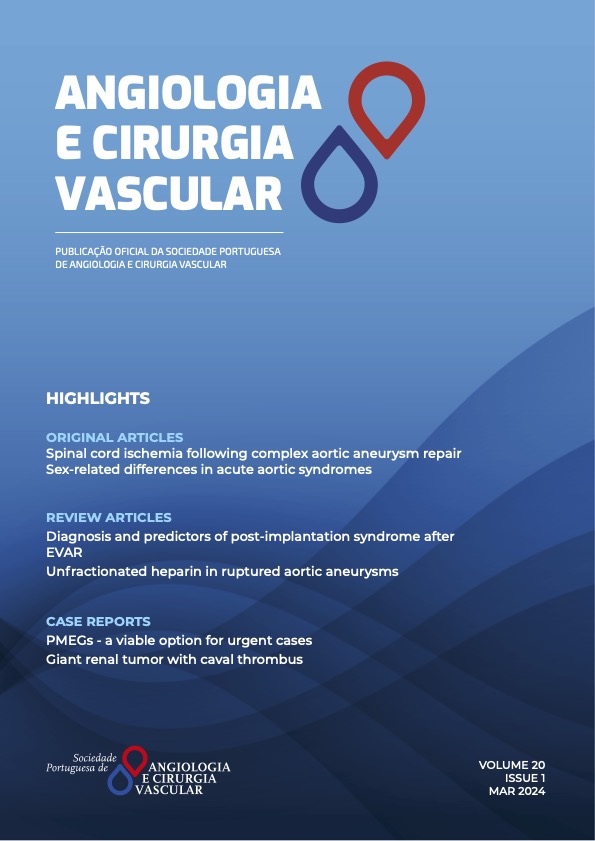Mycotic aneurysm in an immunocompromised patient with pneumonia and spondylodiscitis: who’s guilty?
DOI:
https://doi.org/10.48750/acv.559Keywords:
Mycotic Aneurysm, Infected Aneurysm, Bacterial Aneurysm, Klebsiella pneumoniaeAbstract
BACKGROUND: Mycotic aneurysm is a rare entity with rapid progression, which can be fatal without adequate treatment. The incidence of rupture is greater than that of degenerative aneurysms and is associated with a high mortality rate.CASE REPORT: We report the case of a 58-year-old man with a known history of HIV infection with good immunovirological staging, treated squamous cell carcinoma of the anal canal and chronic gastritis, who presented with a six-day history of intense back pain, malaise, fever, and chills. After examination, he was hospitalized with a clinical suspicion of acute pyelonephritis. During hospitalization, he was diagnosed with pneumonia of the right pulmonary base, infectious spondylodiscitis, and mycotic aneurysm of the abdominal aorta, which involved the visceral plaque. The microbiological workup revealed only positive blood cultures for Klebsiella pneumoniae. After a multidisciplinary discussion of the case and six weeks of antibiogram-oriented antibiotic therapy, the patient underwent an aorto-aortic interposition via left thoracophrenolaparotomy without the need to reimplant visceral vessels due to the patch configuration of the proximal anastomosis. The procedure was performed under left heart bypass. The postoperative course was uneventful, and the patient was discharged four weeks later. At 18 months follow-up, she remained asymptomatic and free of recurrence.
CONCLUSION: In this case, it remains to be defined whether the cause of the mycotic aneurysm was hematogenous dissemination from the identified pneumonia or contiguity from the diagnosed spondylodiscitis. Given the morbidity and mortality associated with this entity, early diagnosis and adequate treatment with surgical correction and antibiotic therapy with sufficient duration and dose are important aspects for improving survival in these cases.
Downloads
References
Sörelius K, Wanhainen A, Mani K. Infective native aortic aneurysms: call for consensus on the definition, terminology, diagnostic criteria, and reporting standards. Eur J Vasc Endovasc Surg. 2020, 59.3: 333-4.
Jönsson A, Ljungquist O, Sörelius K. HIV‐associated infective native aortic aneurysms. APMIS, 2023, 131.1: 3-12.
Liesker DJ, Mulder DJ, Wouthuyzen-Bakker M, Prakken NH, Slart RH, Zeebregts CJ, et al. Patient-tailored approach for diagnostics and treatment of mycotic abdominal aortic aneurysm. Ann Vasc Surg. 2022, 84: 225-38.
Touma J, Couture T, Davaine JM, de Boissieu P, Oubaya N, Michel C, et al. Mycotic/infective native aortic aneurysms: results after preferential use of open surgery and arterial allografts. Eur J Vasc Endovasc Surg. 2022, 63:475-83.
Totsugawa T, Kuinose M, Yoshitaka H, Tsushima Y, Ishida A, Minami H. Mycotic Aortic Aneurysm Induced by Klebsiella Pneumoniae Successfully Treated by In-Situ Replacement with Rifampicin-Bonded Prosthesis Report of 3 Cases. Circ J. 2007;71:1317-20.
Kim SD, Hwang JK, Moon IS, Park SC. Surgical management of ruptured mycotic aortic aneurysm induced by Klebsiella pneumoniae. Chin Med J 2019;132:89-91.
Wanhainen A, Verzini F, Van Herzeele I, Allaire E, Bown M, Cohnert T, et al. Editor's choice–European Society for Vascular Surgery (ESVS) 2019 clinical practice guidelines on the management of abdominal aorto-iliac artery aneurysms. Eur J Vasc Endovasc Surg. 2019;57: 8-93.
Han M, Wang J, Zhao J, Ma Y, Huang B, Yuan D, et al. Systematic review and meta-analysis of outcomes following endovascular and open repair for infective native aortic aneurysms. Ann Vasc Surg, 2022;79:348-58.
Sörelius K, Prendergast B, Fosbøl E, Søndergaard L. Recommendations on securing microbiological specimens to guide the multidisciplinary management of infective native aortic aneurysms. Ann Vasc Surg 2020;68:536-41.
Byun HG, Kim Y, Lee JH, Lee J, Park KS. Successful Endovascular Treatment of an Infected Aortic Aneurysm Induced by Klebsiella pneumoniae. Taehan Yongsang Uihakhoe Chi 2020;81:733-8









